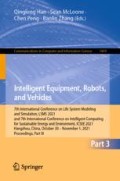Abstract
Rough k-means algorithm can effectively deal with the problem of the fuzzy boundaries. But traditional rough k-means algorithm set unified weight for boundary object, ignoring the differences between individual objects. Membership degree method of rough fuzzy k-means algorithm is used to measure the membership degree of boundary object to the clusters that they may belong to, ignoring the distribution of neighbor points of the boundary object. So, according to the distribution of neighbor points of the boundary object, we put forward a new rough k-means algorithm to measure the weight of boundary objects. The proposed algorithm considers the distance from boundary objects to their neighbor points and the number of neighbor points of boundary objects together to dynamically calculate the weights of boundary object to clusters that may belong to. Simulation and experiment, through examples verify the effectiveness of the proposed method.
Access this chapter
Tax calculation will be finalised at checkout
Purchases are for personal use only
References
Huang, D., Lai, J.H., Wang, C.D.: Combining multiple clusterings via crowd agreement estimation and multi-granularity link analysis. J. Neurocomput. 170, 240–250 (2015)
Xu, R., Wunsch, D.: Survey of clustering algorithms. J. IEEE Trans. Neural Netw. 16, 645–678 (2005)
Zhou, S., Xu, Z., Tang, X.: A method for determining the optimal number of clusters based on affinity propagation clustering. J. Control Decis. 26, 1147–1152, 1157 (2011)
Hartigan, J.A., Wong, M.A.: A k-means clustering algorithm. J. Appl. Stat. 28, 100–108 (1979)
Amorim, R.C.: A survey on feature weighting based k-means algorithms. J. Classif. 33, 210–242 (2016)
Khandare, A., Alvi, A.S.: Survey of improved k-means clustering algorithms: improvements, shortcomings and scope for further enhancement and scalability. In: Satapathy, S.C., Mandal, J.K., Udgata, S.K., Bhateja, V. (eds.) Information Systems Design and Intelligent Applications. AISC, vol. 434, pp. 495–503. Springer, New Delhi (2016). https://doi.org/10.1007/978-81-322-2752-6_48
Pawlak, Z.: Rough sets. Int. J. Comput. Inf. Sci. 11, 341–356 (1982)
Lingras, P., West, C.: Interval set clustering of web users with rough k-means. J. Intell. Inf. Syst. 23, 5–16 (2004)
Dou, C., Zhang, Z., Yue, D., Song, M.: Improved droop control based on virtual impedance and virtual power source in low-voltage microgrid. J. LET Gener. Transm. Distrib. 11(4), 1046–1054 (2017)
Dou, C., Yue, D., Li, X., Xue, Y.: MAS-based management and control strategies for integrated hybrid energy system. J. IEEE Trans. Ind. Inform. 12(4), 1332–1349 (2016)
Peters, G.: Some refinements of rough k-means clustering. J. Pattern Recogn. 39, 1481–1491 (2006)
Zhang, T., Chen, L., Ma, F.: A modified rough c-means clustering algorithm based on hybrid imbalanced measure of distance and density. J. Int. J. Approx. Reasoning 55, 1805–1818 (2014)
Peters, G.: Rough clustering utilizing the principle of indifference. J. Inf. Sci. 277, 358–374 (2014)
Jiang, Z., Li, T., Min, W., et al.: Fuzzy c-means clustering based on weights and gene expression programming. J. Pattern Recogn. Lett. 90, 1–7 (2017)
Chen, H.P., Shen, X.J., Lv, Y.D., et al.: A novel automatic fuzzy clustering algorithm based on soft partition and membership information. J. Neurocomputing 236, 104–112 (2017)
Maji, P., Pal, S.K.: RFCM. A hybrid clustering algorithm using rough and fuzzy sets. J. Fundamenta Informaticae. 80, 475–496 (2007)
Mitra, S., Banka, H., Pedrycz, W.: Rough–fuzzy collaborative clustering. J. IEEE Trans. Syst. Man Cybern. Part B (Cybern.) 36, 795–805 (2006)
Paul, S., Maji, P.: A new rough-fuzzy clustering algorithm and its applications. In: Babu, B.V., et al. (eds.) Proceedings of the Second International Conference on Soft Computing for Problem Solving (SocProS 2012), December 28-30, 2012. AISC, vol. 236, pp. 1245–1251. Springer, New Delhi (2014). https://doi.org/10.1007/978-81-322-1602-5_130
Shi, J., Lei, Y., Zhou, Y., et al.: Enhanced rough–fuzzy c-means algorithm with strict rough sets properties. J. Appl. Soft Comput. 46, 827–850 (2016)
Li, F., Liu, Q.: An extension to rough c-means clustering algorithm based on boundary area elements discrimination. In: Peters, J.F., Skowron, A., Ramanna, S., Suraj, Z., Wang, X. (eds.) Transactions on Rough Sets XVI. LNCS, vol. 7736, pp. 17–33. Springer, Heidelberg (2013). https://doi.org/10.1007/978-3-642-36505-8_2
Weng, S., Dong, Y., Dou, C., Shi, J., Huang, C.: Distributed event-triggered cooperative control for frequency and voltage stability and power sharing in isolated inverter-based microgrid. J. IEEE Trans. Cybern. 49(4), 1427–1439 (2018)
Acknowledgments
This work was supported by the National Natural Science Foundation of China under Grant 62073173 and 61833011, the Natural Science Foundation of Jiangsu Province, China under Grant BK20191376, the University Natural Science Foundation of Jiangsu Province under Grant TJ219022.
Author information
Authors and Affiliations
Editor information
Editors and Affiliations
Rights and permissions
Copyright information
© 2021 Springer Nature Singapore Pte Ltd.
About this paper
Cite this paper
Zhong, P., Zhang, T., Zhang, X., Hu, X., Zhang, W. (2021). Rough K-means Algorithm Based on the Boundary Object Difference Metric. In: Han, Q., McLoone, S., Peng, C., Zhang, B. (eds) Intelligent Equipment, Robots, and Vehicles. LSMS ICSEE 2021 2021. Communications in Computer and Information Science, vol 1469. Springer, Singapore. https://doi.org/10.1007/978-981-16-7213-2_30
Download citation
DOI: https://doi.org/10.1007/978-981-16-7213-2_30
Published:
Publisher Name: Springer, Singapore
Print ISBN: 978-981-16-7212-5
Online ISBN: 978-981-16-7213-2
eBook Packages: Computer ScienceComputer Science (R0)

